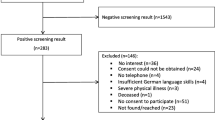Abstract
Thirty inpatients with somatoform disorders were examined with the structured clinical interview SCID for psychiatric lifetime diagnosis. In the present diagnoses, we found a concordance of 63% for somatoform and affective disorders and the lifetime comorbidity of both disorders was 87%. Additionally, patients with somatoform disorders frequently had a history of other psychiatric disorders (for example, anxiety disorders, 40%). For 73% of patients with somatoform disorders and a history of affective disorders, the onset of the somatoform disorder was prior to the onset of another psychiatric disorder. The time interval between the onsets of somatoform disorders and affective disorders was greater than 1 year for most patients; for 46% of the patients with a history of both disorders, the time interval between the two disorders was more than 5 years. The course of illness for somatoform and affective disorders was quite different; while affective disorders tended to episodic periods with interim remissions, the somatoform disorders usually showed long, chronic courses (mean duration of the current somatoform disorder was 11.9 years). Finally, the Symptom Check List SCL-90R demonstrated good discrimination between patients with affective and anxiety disorders. However, the SCL-90R failed to discriminate patients with somatoform disorders from affective- and anxiety-disordered subjects. Therefore, the development of other psychometric scales is necessary for the evaluation of patients with somatoform disorders.
Similar content being viewed by others
References
American Psychiatric Association (1980) Diagnostic and statistical manual for mental disorders, 3rd edn. American Psychiatric Association, Washington, DC
American Psychiatric Association (1987) Diagnostic and statistical manual for mental disorders, 3rd edn (revised). American Psychiatric Association, Washington, DC
Brown GW and Harris TO (1982) Social origins of depression. Tavistock Publications, London
Chiu LPW and Rimón R (1987) Relationship of migration to paranoid and somatoform symptoms in chinese patients. Psychopathology 20:203–212
CIPS (1986) Internationale Skalen für Psychiatrie [International Scales for Psychiatry]. Beltz, Weinheim
de Leon J, Saiz-Ruiz J, Chinchilla A and Morales P (1987) Why do some psychiatric patients somatize? Acta Psychiatr Scand 76: 203–209
Derogatis LR, Lipman RS, Rickels K, Uhlenhuth EH and Covi L (1974) The Hopkins symptom check list HSCL: a self report symptom inventory. Behav Sci 19:1–15
Escobar JI, Rubio-Stipec M, Canino G and Karno M (1989) Somatic Symptom Index: a new and abridged somatization construct. J Nerv Mental Dis 177:140–146
Fabrega H, Mezzich J, Jacob R and Ulrich R (1988) Somatoform disorders in a psychiatric setting-systematic comparisons with depression and anxiety disorders. J Nerv Ment Dis 176:431–439
Garnefski N, van Engmont M and Straatman A (1990) The influence of early and recent life stress on severity of depression. Acta Psychiatr Scand 81:295–301
Golding JM, Smith R and Kashner TM (1991) Does somatization disorder occur in men? Arch Gen Psychiatry 48:231–235
Kellner R, Abbott P, Winslow WW and Pathak D (1987) Fears, beliefs, and attitudes in DSM-III hypochondriasis. J Nerv Ment Dis 175:20–25
Lipowski ZJ (1986) Somatization: a borderland between medicine and psychiatry. Can Med Assoc J 135:609–614
Lipowski ZJ (1987) Somatization: Medicine's unsolved problem. Psychosomatics 28:294–297
Lipowski ZJ (1990) Somatization and depression. Psychosomatics 31:13–21
Morrison J and Herbstein J (1988) Secondary affective disorder in women with somatization disorder. Compr Psychiatry 29:433–440
Persson L and Sjöberg L (1987) Mood and somatic symptoms. J Psychosom Res 31:499–511
Rief W, Greitemeyer M and Fichter MM (1991) Die Symptom Check List SCL-90R: Überprüfung an 900 psychosomatischen Patienten [The Symptom Check List SCL-90R: Evaluation of the results of 900 psychosomatic inpatients]. Diagnostica 37:58–65
Rief W, Schäfer S and Fichter MM (1992) SOMS: ein Screening-Verfahren zur Identifizierung von Personen mit Somatoformen Störungen [SOMS — a screening instrument to identify subjects with somatoform disorders]. Diagnostica in press
Robinson JO, Alverez JH and Dodge JA (1990) Life events and family history in children with recurrent abdominal pain. J Psychosom Res 34:171–181
Scaloubaca D, Slade P and Creed F (1988) Life events and somatization among students. J Psychosom Res 32:221–229
Shrout PE, Link BG, Dohrenwend BP, Skodol AE, Stueve A and Mirotznik J (1989) Characterizing life events as risk factors for depression: The role of fateful loss events. J Abnorm Psychol 98:460–467
Silver H (1987) Physical complaints are part of the core depressive syndrome: Evidence from a cross-cultural study in Isreal. J Clin Psychiatry 48:140–142
Smith GR, Monson RA and Ray DC (1986) Patients with multiple unexplained symptoms. Arch Intern Med 146:69–72
Spitzer RL and Williams JB (1987) Structured clinical Interview for DSM-III-R (SCID) New York: Biometric Research Dep., NYS Psychiatric Institute
Spitzer RL, Williams JBW, Gibbon M and First MB (1990) SCID — Structured clinical interview for DSM-III-R, Washington: American Psychiatric Press
Stoudemire A, Lingfors E, Kahn M, Houpt JL and Brown JT (1985) Masked depression in a combined medical-psychiatric unit. Psychosomatics 26:221–228
Wittchen HU, Schramm E, Zaudig M, Spengler P, Rummler R and Mombour W (1990) Strukturiertes klinisches Interview für DSM-III-R. Weinheim Beltz Test
Zoccolillo MS and Cloninger R (1986) Excess medical care of women with somatization disorder. South Med J 79:532–535
Author information
Authors and Affiliations
Rights and permissions
About this article
Cite this article
Rief, W., Schaefer, S., Hiller, W. et al. Lifetime diagnoses in patients with somatoform disorders: Which came first?. Eur Arch Psychiatry Clin Nuerosci 241, 236–240 (1992). https://doi.org/10.1007/BF02190259
Received:
Issue Date:
DOI: https://doi.org/10.1007/BF02190259




